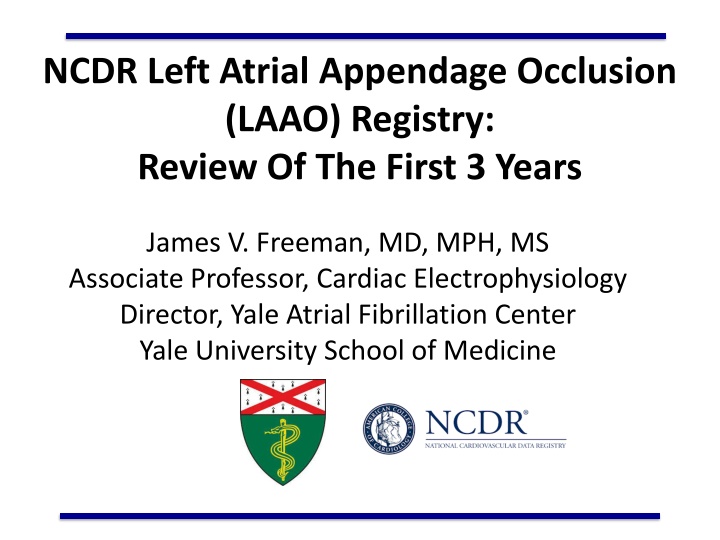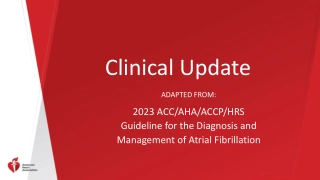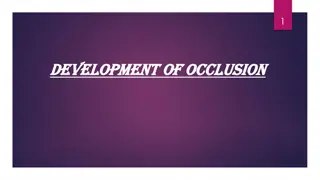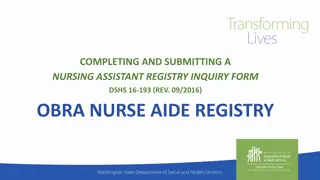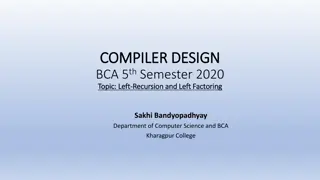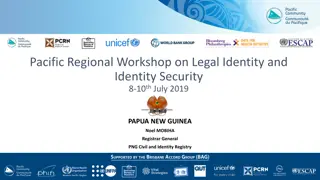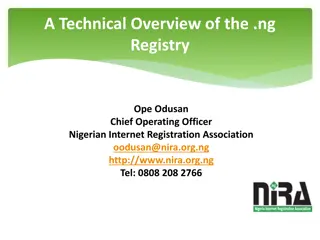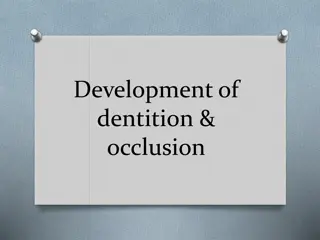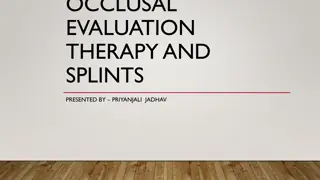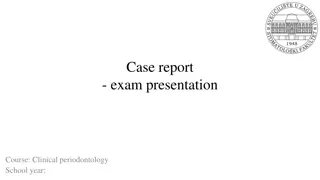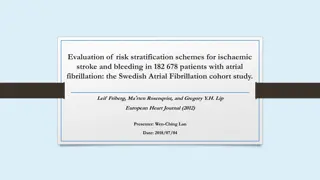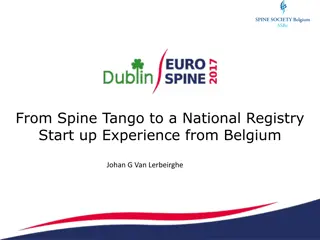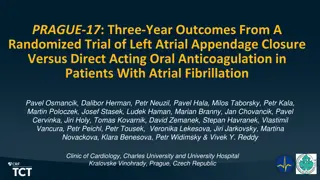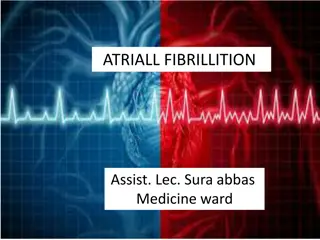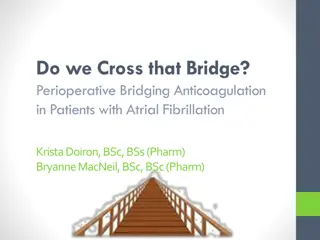NCDR Left Atrial Appendage Occlusion (LAAO) Registry: Review Of The First 3 Years
This summary provides insights into the NCDR Left Atrial Appendage Occlusion (LAAO) Registry's first 3 years, including development, collaboration details, enrollment specifics, data elements, procedures, participating physicians and hospitals, and the cumulative number of procedures. The registry supports post-market FDA surveillance and collection of adverse events for CMS reimbursement. It includes key disclosures and the progression of LAAO procedures over time, showcasing a growing trend in utilization.
Download Presentation

Please find below an Image/Link to download the presentation.
The content on the website is provided AS IS for your information and personal use only. It may not be sold, licensed, or shared on other websites without obtaining consent from the author.If you encounter any issues during the download, it is possible that the publisher has removed the file from their server.
You are allowed to download the files provided on this website for personal or commercial use, subject to the condition that they are used lawfully. All files are the property of their respective owners.
The content on the website is provided AS IS for your information and personal use only. It may not be sold, licensed, or shared on other websites without obtaining consent from the author.
E N D
Presentation Transcript
NCDR Left Atrial Appendage Occlusion (LAAO) Registry: Review Of The First 3 Years James V. Freeman, MD, MPH, MS Associate Professor, Cardiac Electrophysiology Director, Yale Atrial Fibrillation Center Yale University School of Medicine
Disclosures Research funding/ Salary support NHLBI/NIH American College of Cardiology (ACC) Advisory board/ Consulting- modest Medtronic Boston Scientific Janssen Pharmaceuticals Biosense Webster
NCDR LAAO Registry WATCHMAN approved in March 2015 LAAO Registry developed through a collaboration ACC, SCAI, FDA, CMS, Boston Scientific LAAO Registry launched late December 2015 Enrollment began in January 2016 Mandated for CMS reimbursement Supports post-market FDA surveillance study
LAAO Registry Hospitals are encouraged to submit data on all WATCHMAN ~90% of hospitals do Includes Lariat procedures; can support additional devices Data elements 220 for index hospitalization 60 per follow-up visit 15 to support adverse event (AE) adjudication Adjudication performed using electronic algorithm and clinical events committee for some events Active follow-up for AEs and medical therapy though 2 years CMS claims for collection of AEs in years 3-4
Cumulative Procedures 45000 12/2018=38,158 40000 35000 30000 25000 20000 15000 10000 5000 0 DEC,2016 FEB,2016 JUL,2016 FEB,2017 DEC,2017 FEB,2018 JUL,2018 DEC,2018 MAY,2016 MAY,2017 MAY,2018 APR,2016 OCT,2016 APR,2017 OCT,2017 NOV,2017 APR,2018 OCT,2018 JAN,2016 JUN,2016 SEP,2016 JUN,2017 SEP,2017 JUN,2018 SEP,2018 MAR,2016 MAR,2017 MAR,2018 AUG,2016 NOV,2016 JAN,2017 JULY,2017 AUG,2017 JAN,2018 AUG,2018 NOV,2018 Freeman, JACC, 2020.
Participating Physicians and Hospitals 12/2018=1,318 1400 Cumulative Number of Physicians Cumulative Number of Hospitals 1200 1000 800 12/2018=495 600 400 200 0 JUL,2016 JUL,2018 FEB,2016 DEC,2016 FEB,2017 DEC,2017 FEB,2018 DEC,2018 MAY,2016 MAY,2017 MAY,2018 MAR,2016 APR,2016 OCT,2016 APR,2017 OCT,2017 APR,2018 OCT,2018 JUN,2016 SEP,2016 JUN,2017 SEP,2017 JUN,2018 SEP,2018 MAR,2017 MAR,2018 JAN,2016 AUG,2016 NOV,2016 JAN,2017 JULY,2017 AUG,2017 NOV,2017 JAN,2018 AUG,2018 NOV,2018
Patient Characteristics LAAO Registry 2016-2018 (N=38,158) PROTECT AF trial 2005-2008 (N=463 implants) PREVAIL trial 2011-2013 (N=269 implants) EWOLUTION Registry 2013-2015 (N=1025) Characteristic Demographics Age, mean (SD), year Women, N (%) Race, N (%) White/European Black/African American Asian/Pacific Islander Hispanic ethnicity, N (%) Medical History Prior ischemic stroke/TIA, N (%) Prior congestive heart failure, N (%) Prior diabetes mellitus, N (%) Prior hypertension, N (%) Prior intracranial bleeding, N (%) Prior clinical bleeding, N (%) Prior clinically relevant bleeding, N (%) 76.0 (8.1) 15,672 (41.1) 71.7 (8.8) 137 (29.6) 74.0 (7.4) 87 (32.3) 73.4 (8.9) 411 (40.1) 35,345 (92.6) 1768 (4.6) 670 (1.8) 138 (0.4) 425 (91.8) 6 (1.3) 5 (1.1) 25 (5.4) 253 (94.1) 6 (2.2) 1 (0.4) 6 (2.2) NA NA NA NA 10,425 (29.8) 14,266 (37.4) 14,396 (37.7) 35,148 (92.1) 4550 (11.9) 26,466 (69.4) 26,466 (69.4) 82 (17.7) 124 (26.8) 113 (24.4) 413 (89.2) NA NA NA 74 (27.5) 63 (23.4) 91 (33.8) 238 (88.5) NA NA NA 312 (30.5) 350 (34.2) 304 (29.7) 885 (86.4) 155 (15.1) 396 (38.7) 396 (38.7)
LAAO Registry: CHA2DS2 VASc Scores 30 Mean CHA2DS2 VASc Scores - LAAO = 4.6 (SD 1.5) - PROTECT AF = 3.4 (SD 1.5) - PREVAIL = 3.8 (SD 1.2) - EWOLUTION = 4.5 (SD 1.6) 25 Percent of Population 20 15 10 5 0 0 1 2 3 4 5 6 7 8 9 CHA2DS2-VASc Risk Score
HAS BLED Score Distribution 40 Mean HAS BLED Scores - LAAO = 3 (SD 1.1) - EWOLUTION = 2.3 (1.2) 35 Percent of Population 30 25 20 15 10 5 0 0 1 2 3 4 5 6 7 8 HAS-BLED risk scores
Annual Hospital Volume 120 Median 30 (IQR 18-44) 100 Number of Hospitals 80 60 40 20 0 <10 10 to 19 20 to 29 30 to 39 40 to 49 50 to 59 60 to 69 70 to 79 >=80 Annual Case Volume
Annual Physician Volume 600 Median 12 (IQR 8-20) 500 Number of Physicians 400 300 200 100 0 <10 10 to 19 20 to 29 30 to 39 40 to 49 >=50 Annual Case Volume
Cancelled and Aborted Procedures Device deployed in 93% of procedures attempted 3% cancelled prior to venous access 4% aborted after access but before deploying device Approximately 50% of cancelled procedures due to LAA thrombus detected on day of procedure Rates of major AEs significantly higher among those who had cancelled or aborted procedures
Procedural Success 98.5% 98.3 * 94.8% 95.1% 100 94.4% 90.9% 90 Percent of Procedures 80 70 60 50 40 30 20 10 0 PROTECT-AF CAP PREVAIL CAP2 EWOLUTION LAAO *Acute procedural success= rate of success among procedures in which a device was deployed. Among those with an acutely successful procedure 70 (0.2%) had device margin residual leak 5mm
Major In-hospital AEs 2.5 2.16% 2.0 Percent of Procedures 1.39% 1.5 1.25% 1.0 0.5 0.24% 0.19% 0.17% 0.15% 0.0 Any Major Complication* Complication Pericardial Effusion Requiring Intervention Major Bleeding Cardiac Arrest Major Bleeding Death Stroke/TIA Major Vascular Complication Any Major
Major In-hospital AEs Overall Adverse Event Type Neurologic Events Ischemic Stroke Hemorrhagic Stroke 38158 N 100.00 % 45 3 0.12 0.01 Undetermined stroke 2 0.01 TIA Intracranial Hemorrhage 16 3 0.04 0.01 Systemic Arterial Embolism 1 <0.01 Myocardial Infarction 14 0.04 Device Embolization 30 0.07
Adverse Events Compared with Prior Studies Major in-hospital AEs (2.16%) lower than those reported in the pivotal trials at 7 days PROTECT AF Pericardial effusion requiring surgery or pericardiocentesis 4% Major bleeding 3.5% Procedure-related stroke 1.1% Device embolization 0.4% PREVAIL Pericardial effusion requiring surgery or pericardiocentesis 1.9% Procedure-related stroke 0.7% Device embolization 0.7%
Adverse Events Compared with Prior Studies EWOLUTION Registry 7-day procedure related AEs 2.8% 1-day procedure related adverse event rates Pericardial effusion 0.5% Major bleeding 0.7% Device embolization 0.2%
Conclusions NCDR LAAO Registry the largest registry of percutaneous LAAO procedures Over 38,000 WATCHMAN procedures between 2016-2018 Hospital and physician procedure volumes were generally low to moderate but vary substantially
Conclusions Patients were higher risk for stroke and bleeding than prior studies Most with prior clinically relevant bleeding Despite this, procedural characteristics and safety compared favorably with the pivotal trials LAAO Registry demonstrates the value of national registries to evaluate technology as adopted in clinical practice
